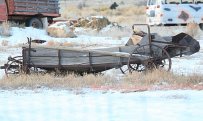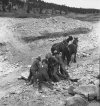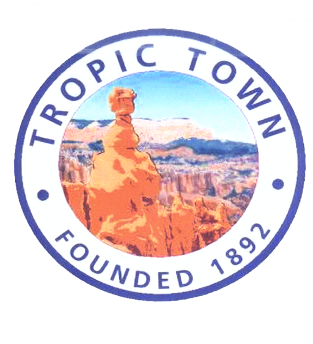Tropic Heritage
The Days Teach Much, The Days Never New
"As the water flowed over the pink cliffs of what is now known today as Water Canyon, shouts of acclamation was heard through out the valley".
Tropic is the first community located east of Bryce Canyon National Park on Utah Highway 12 in Garfield County. The founding of Tropic came about as a direct result of two water projects, Spring Creek and East Fork. It was through the hard work and perseverance of Andrew J. Hansen, William Lewman and Ole Ahlstrom that the vision of supplying water to the valley was fulfilled.
Ole Ahlstrom and thirty-nine other men completed the ditch by the spring of 1892. It was on May 23, 1892 that the ten-mile canal brought the waters flowing from the East Fork of the Sevier River over the cliffs of Bryce Canyon into the Tropic Valley, a drop of 1,500 feet; the only streem so far known to have been diverted from the Great Inland Basin, and which would eventually find its way into the Gulf of California through the big Colorado River. It was reported that prior to releasing the water, Mr. Hansen found a group of people camped on the East Fork and gave warning to move to higher ground; they didn't and he reported hearing them shouting and cusing in the night when their camp flooded. Citizens joined together at the home of Caroline and A.J. Hansen to commemorate the event. The grand celebration consisted of a barbecue of beef, veal, lamb and mutton; cake, pie and many other tastey food was enjoyed by the old and young.

The organization of the community began when Andrew J. Hansen, William Lewman and James Ahlstrom survey the townsite in the spring of 1889. It included sixteen blocks of four lots per block, each lot measuring one and a quater acre. Sixty-four lots were sold at $7.50 per lot; this low price brought attracted additional settlers: William, John F. and Dan Pollock, John Ahlstrom, Joseph and James Robert Ott, Will Chatwin; George Shakespear; William and John Spendlove, Levison Hancock, Henry and Willam B. Mecham, John Maneill, Orin Mangum, Seth Alvin, Sena Schow Johnson and Andrew Perkins all came to make their homes in Tropic.
The name of the town had been a matter of discussion, the first among many was Erastus, in honor of a LDS (Mormon) Apostle; this along with UR, Hansen and others. It was suggested by Andrew J. Hansen to call it "Tropic". To support the suggestion, he state that people would come to their little valley where peaches, apples, grapes and other semi-tropical fruits would be found. The name Tropic was adopted; with the population of about 15 families.
With neighboring Bryce Canyon National Park being a well-known tourist destination, the once small farming community has flourish, welcoming visitors from both near and far. Most residents are descendants of pioneer stock and through the hard work and determination of their ancestors the task of providing water to the valley was accomplished. It was no small feat then, and it is the same water today, which provides the irrigation for crops, gardens and gives life to the valley. Residents and visitors alike awe at the beauty surrounding them each day.
From the dedicated and hardworking pioneers to their sophisticated modernize descendants, "The years continue to teach what the days never knew".
Southern Utah Oral History Research Project
A collection of oral interviews have been transcribed and are being digitized. The "Southern Utah Oral History Project" is now available at the SUU Sherratt Library. Log on to www.li.suu.edu in the digital collection "Grand Staircase Escalante National Monument Collection" ~ Scroll down to roman numeral IX ~ Oral Histories. Copies of these interviews are available at the Tropic Town office for "In-House" view only. Copies can be made upon request. Thank you Marsha Holland for all your talent, hard work and valuable time dedicated to this project and for allowing Tropic Town to preserve a copy of these histories.
Southern Utah Oral History Research Project

Digging Tropic Ditch
Tropic Scout House
Tropic Valley Today
History
